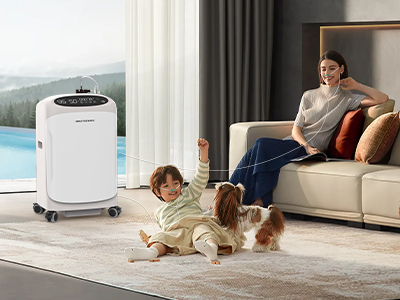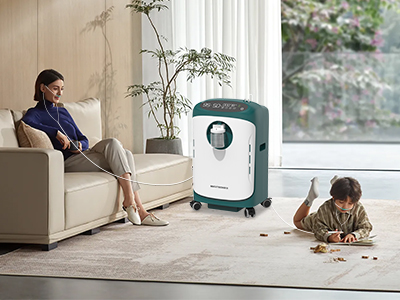14 Jul 2025
When one child in the family needs oxygen therapy, it’s not just the medical equipment that makes its grand entrance—it’s also a new cast of questions, emotions, and “What’s that thing in their nose?” moments from siblings. The arrival of home oxygen can stir up curiosity, confusion, and even a pinch of jealousy.
But here’s the good news: kids are wildly adaptable. With a bit of guidance (and maybe a few deep breaths of your own), you can help brothers and sisters become understanding sidekicks, rather than bewildered bystanders.

Start with the Basics—Explain, Don’t Lecture
Children are naturally inquisitive. If you don’t explain what oxygen therapy is, they’ll make up their own version—and spoiler alert: it will probably involve aliens, robots, or an invisible dragon living in the tubing.
Age-Appropriate Talking Points:
Toddlers (1–3): “This tube helps your brother breathe better. It’s like giving his lungs a little hug.”
Preschoolers (3–5): “Your sister’s body is still learning to breathe all by itself, so this machine is helping her until she’s stronger.”
School-Age Kids (6–12): “Oxygen is something we all need to live. The air we breathe has it, but your sibling needs a little extra to help their body work right.”
Teens: Just go full science—charts, percentages, diagrams, memes if necessary. They’ll roll their eyes but secretly appreciate the clarity.
You’re not delivering a TED Talk. You’re building understanding—one honest sentence at a time.
Demystify the Equipment (a.k.a. The Tube Parade)
Oxygen concentrators. Nasal cannulas. Tanks on wheels that hiss. To the untrained sibling eye, this is either a space mission or a villain’s lair.
Make it fun. Make it factual. Make it less scary.
Tips for Introducing the Gear:
Let them touch and explore (safely). Show them how the tubing works and where it goes.
Give the equipment nicknames: “That’s Olivia the Oxygenator” or “Captain Cannula.” It humanizes the hardware and diffuses fear.
Explain the sounds: “That beep means it’s working too hard” or “That hiss means it’s doing its job.”
Knowledge reduces fear. And once they know what’s what, the machines lose their mystery—and their menace.
Address the Elephant (and the Jealousy) in the Room
Oxygen therapy often means more attention, more cuddles, more late-night check-ins—for the child receiving care. And to a sibling watching from the sidelines, it can feel like their spotlight just got dimmed.
Ways to Keep Sibling Hearts Balanced:
Schedule one-on-one time: Even 15 minutes of undivided attention can refill their emotional tank.
Let them help, within reason: Can they fetch a blanket? Press a button? Deliver a toy? Being useful gives them purpose.
Acknowledge their feelings: Say, “I know it’s hard when we have to focus so much on your sister right now. I love you just as much.”
You’re not playing favorites—you’re playing survival. But a little extra empathy goes a long way in keeping sibling bonds strong and intact.
Create a Role: The Sibling Superhero
Every superhero needs a sidekick—and in this case, every child on oxygen needs a sibling ally. Empower your other kids to be advocates, protectors, and proud explainers.
Ways to Activate Their Inner Hero:
Create a “helper badge” or secret club for siblings who learn about oxygen and how to help.
Teach them a “safe word” to use if they see tubing caught, unplugged, or out of place.
Involve them in care without pressure: Maybe they learn how to roll the tubing or keep an eye on the machine during storytime.
Make them feel like part of the team, not part of the audience. They may not wear capes, but they’re doing heroic work behind the scenes.

Normalize the New Normal
Life with oxygen doesn’t have to feel like life on pause. The more you integrate it into everyday routines, the more siblings adjust.
How to Make It Part of the Flow:
Include tubing in the family drawings. If your kid is sketching their sibling, the cannula belongs right there next to the big cartoon eyes.
In family games or activities, plan ahead for mobility needs so the child with oxygen isn’t left out—and neither are the others.
Keep the house rules universal: “No roughhousing near the tubing” applies to everyone, not just the one with the tank.
When the equipment becomes just another part of the household furniture—like the toaster or the dog bed—it loses its shock value.
Be Real About Emotions (Theirs and Yours)
Siblings are allowed to feel all the things—annoyed, confused, scared, proud, curious, resentful. Sometimes all before lunch.
Your Game Plan:
Encourage open conversations: Use dinner time or bedtime as space for checking in.
Use books or videos that normalize medical conditions for kids. Storytelling is a magical mood mediator.
Be honest if you’re feeling overwhelmed, too. Kids smell stress like bloodhounds—they don’t need perfection, just presence.
Your vulnerability gives them permission to feel without fear. That’s a gift far better than perfection.
Celebrate the Sibling Role
They may not be the one with the tubing, but they are warriors in their own right. They’ve learned compassion early. Patience by necessity. Resilience by proximity.
How to Celebrate Them:
Write them notes: “You were such a great helper today.”.
Let them hear praise when they think you’re not looking.
Document their journey, too: a scrapbook, a journal, or even a silly “Sibling of the Year” award.
They’re growing up in the presence of something rare and tender—empathy in action. And that’s worth every cheer you can muster.
Keywords: oxygen therapy
Originally published 14 Jul 2025, updated 14 Jul 2025.